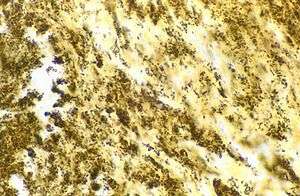Bartonella henselae
| Bartolae | |
|---|---|
 | |
| Scientific classification | |
| Kingdom: | Bacteria |
| Phylum: | Proteobacteria |
| Class: | Alphaproteobacteria |
| Order: | Rhizobiales |
| Family: | Bartonellaceae |
| Genus: | Bartonella |
| Species: | B. henselae |
| Binomial name | |
| Bartonella henselae (Regnery et al. 1992) | |
Bartonella henselae, formerly Rochalimæa, is a proteobacterium that can cause bacteremia, endocarditis, bacillary angiomatosis, and peliosis hepatis. It is also the causative agent of cat-scratch disease[1] (bartonellosis) which, as the name suggests, occurs after a cat bite or scratch. The disease is characterized by lymphadenopathy (swelling of the lymph nodes) and fever.
Peliosis hepatis caused by B. henselae can occur alone or develop with cutaneous bacillary angiomatosis or bacteremia. Patients with peliosis hepatis present with gastrointestinal symptoms, fever, chills, and an enlarged liver and spleen containing blood-filled cavities. This systemic disease is mostly seen in patients infected with HIV and other immunocompromised individuals.
Bartonella henselae is a member of the class of the Bartonella genus, one of the most common types of bacteria in the world. It infects the host cell by sticking to it using the Trimeric Autotransporter Adhesins (TAA).
The presence of bacteria can be detected by a special stain called Warthin-Starry stain, or by a similar silver stain technique performed on infected tissue.
Diagnosis
Bartonella henselae is gram negative rod or bacillus.[2] Bartonella henselae can be cultured in a lysis-centrifugation blood culture.[3] The diagnosis is made after a detailed patient history and physical is taken. A hallmark of the infectious process include history of contact with a cat (hence the name cat scratch disease).
Symptoms
Common symptoms:[4]
- Fever
- Enlarged, tender lymph nodes that develop 1–3 weeks after exposure
- A papule or pustule at the inoculation site
Treatment
Bartonella henselae (cat scratch disease) infections are usually self-limiting, but can be treated with azithromycin, doxycycline.[5]
See also
References
- ↑ Jerris RC, Regnery RL (1996). "Will the real agent of cat-scratch disease please stand up?". Annu. Rev. Microbiol. 50: 707–25. doi:10.1146/annurev.micro.50.1.707. PMID 8905096.
- ↑ Kavita Diddi; Rama Chaudhry; Nidhi Sharma; Benu Dhawan (28 March 2011). "Strategy for identification & characterization of Bartonella henselae with conventional & molecular methods". Indian Journal of Medical Research. 137: 380–387. Retrieved 1 December 2016.
- ↑ Bernard La Scola; Didier Raoult (17 March 1999). "Culture of Bartonella quintana and Bartonella henselae from Human Samples: a 5-Year Experience (1993 to 1998)" (PDF). Journal of Clinical Microbiology. 37 (6): 1899–1905. Retrieved 1 December 2016.
- ↑ "Bartonella Infection (Cat Scratch Disease, Trench Fever, and Carrión's Disease)". Centers for Disease Control and Prevention. 29 November 2012.
- ↑ Bartonellosis~treatment at eMedicine
External links
- "Bartonella henselae". NCBI Taxonomy Browser. 38323.
- Type strain of Bartonella henselae at BacDive - the Bacterial Diversity Metadatabase